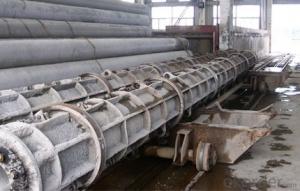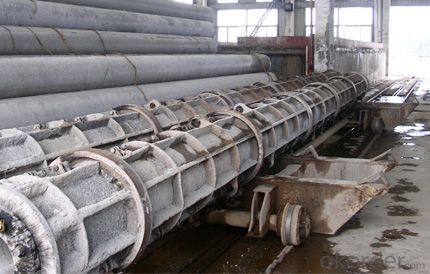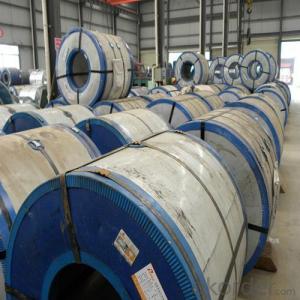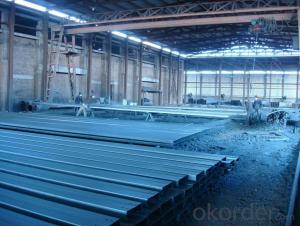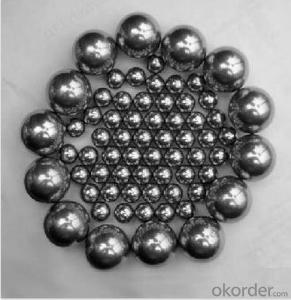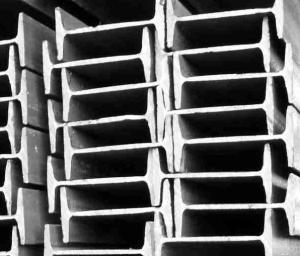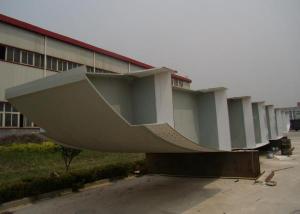TSC Pile
- Loading Port:
- China Main Port
- Payment Terms:
- TT OR LC
- Min Order Qty:
- -
- Supply Capability:
- -
OKorder Service Pledge
Quality Product, Order Online Tracking, Timely Delivery
OKorder Financial Service
Credit Rating, Credit Services, Credit Purchasing
You Might Also Like
We mainly engaged in manufacturing PHC concrete piles with diameters of Φ600~Φ1400 for wharf. Every year, the company produces various types of concrete piles of over 150,000 meters with single-section pile of 41meter long and annual gross output value up to RMB 600 million.
With years’ manufacturing experience of concrete piles and a great number of excellent technological and management talents, the company persists in technical innovation and research of new products. The large-diameter PHC concrete piles with merits such as good bending strength, large bearing capacity, fine resistance against the external force and so forth have been the preferential choice of structural materials for foundation engineering construction such as large ports, wharfs, shipyard, huge bridges, high-rise buildings, heavy factories, high-speed railway, etc.
The company holds the operation philosophy of “honest, practical and harmonious for win-win” and persists in the quality guideline of “constant improvement with prohibition of non-conforming products into construction site” to provide you sincerely with superior products and service.
- Q: What are the transportation guidelines for steel strips?
- The transportation guidelines for steel strips typically include securing the strips properly to prevent movement or damage during transit, using appropriate packaging materials, and following any specific instructions provided by the manufacturer or shipping company. It is also important to consider weight restrictions, load distribution, and compliance with any local or international transportation regulations.
- Q: How do steel rebars affect the overall construction cost of industrial buildings?
- The overall construction cost of industrial buildings can be significantly influenced by steel rebars. These rebars are utilized to reinforce concrete structures, providing strength and durability. The cost is directly affected by the amount of steel rebars required in a building project, as the price of steel is a major component of the overall construction expenses. To begin with, the size, design, and complexity of the industrial building determine the quantity of rebars needed. Larger buildings or those with intricate architectural features may necessitate a greater number of rebars, resulting in increased costs. Furthermore, the design and engineering requirements for seismic or wind resistance can also impact the quantity of rebars, thus affecting the construction budget. Furthermore, the cost can be influenced by the quality and grade of the steel rebars used. Higher-grade rebars, such as those with superior tensile strength or corrosion resistance, may entail higher expenses. Nevertheless, the utilization of higher-grade rebars can provide long-term benefits by enhancing the structural integrity of the building and reducing maintenance and repair costs throughout its lifespan. Additionally, transportation and handling costs contribute to the overall cost. Steel rebars are heavy and bulky, necessitating careful handling and transportation to the construction site. The distance between the steel supplier and the site can have a significant impact on transportation costs. Moreover, the storage and protection of rebars on-site must be considered to ensure their quality, which may result in additional expenses. Lastly, labor costs associated with the installation of steel rebars should be taken into account. Skilled labor is required to accurately place and tie the rebars according to design specifications and building codes. The complexity of the reinforcement design can affect the time required for installation, ultimately influencing labor costs. In conclusion, steel rebars are of utmost importance in the construction of industrial buildings as they reinforce concrete structures. The quantity, quality, transportation, and labor costs associated with steel rebars directly affect the overall construction cost. Therefore, careful planning and consideration of these factors are necessary to effectively manage the budget of industrial building projects.
- Q: What are the different types of steel angles and their applications in the construction of bridges?
- There are primarily three types of steel angles used in the construction of bridges: equal angles, unequal angles, and inverted angles. Equal angles have both sides of equal length and are commonly used as structural components in bridge piers and towers. They provide stability and support to the overall structure. Unequal angles have one side longer than the other, and they are often used in bridge trusses and beams. These angles help distribute the load and provide strength to the bridge. Inverted angles, also known as L-shaped angles, are used as stiffeners in various bridge components such as girders, columns, and beams. They help resist bending and provide additional strength to critical areas of the bridge. Overall, the different types of steel angles play a crucial role in the structural integrity and stability of bridges, ensuring their durability and ability to withstand heavy loads and environmental factors.
- Q: Can stainless steel pipes be stress relieved?
- Yes, stainless steel pipes can be stress relieved. Stress relieving is a heat treatment process used to reduce stress-induced distortion and improve the mechanical properties of the material. Stainless steel pipes can undergo stress relieving at high temperatures, typically between 900°C and 1050°C (1652°F and 1922°F), followed by slow cooling. This process helps to relieve residual stresses that may have been induced during manufacturing processes such as welding or forming. Stress relieving can also enhance the corrosion resistance and improve the overall performance of stainless steel pipes.
- Q: How does special steel contribute to reducing product failure?
- Special steel contributes to reducing product failure by providing enhanced strength, durability, and resistance to various external factors such as corrosion, wear, and extreme temperatures. Its unique properties make it suitable for critical components and applications where failure could have severe consequences. By using special steel in the manufacturing process, products are less likely to fail prematurely, ensuring reliability, safety, and ultimately reducing the risk of accidents or malfunctions.
- Q: What are the main factors affecting the market growth of steel wire rod?
- The main factors affecting the market growth of steel wire rod include the overall demand for steel products, economic growth and industrial development, infrastructure investments, technological advancements in manufacturing processes, fluctuations in raw material prices, competition within the industry, and government regulations and policies related to trade and production.
- Q: Can stainless steel angle be used in railway infrastructure?
- Yes, stainless steel angle can be used in railway infrastructure. Stainless steel is known for its high strength and corrosion resistance, making it suitable for various applications in the railway industry. Stainless steel angle can be used for structural support, such as in the construction of platforms, bridges, and railway stations. It can also be used for installing railings, stairs, and walkways, providing safety and stability to passengers and railway staff. Additionally, stainless steel angle can withstand harsh weather conditions and requires minimal maintenance, making it a durable and cost-effective choice for railway infrastructure.
- Q: Are stainless steel pipes suitable for wastewater pumping stations?
- Yes, stainless steel pipes are suitable for wastewater pumping stations. Stainless steel is a highly corrosion-resistant material, making it particularly well-suited for environments with high levels of moisture and chemicals, such as wastewater pumping stations. It is resistant to rust and can withstand the corrosive nature of wastewater, which can contain various chemicals and contaminants. Stainless steel pipes also have high strength and durability, enabling them to handle the pressure and flow requirements of wastewater pumping systems. Additionally, stainless steel pipes offer a smooth interior surface, which helps to minimize friction and improve the efficiency of water flow. Overall, stainless steel pipes are an excellent choice for wastewater pumping stations due to their corrosion resistance, strength, and durability.
- Q: Can steel sheets be used for safety barriers or guardrails?
- Safety barriers or guardrails can indeed utilize steel sheets. The construction industry frequently employs steel sheets due to their robustness, durability, and ability to withstand impacts. These sheets can be molded into various forms, allowing for the creation of safety barriers or guardrails that effectively safeguard against accidents. Common applications of steel sheets in this context include road safety barriers, highway guardrails, and industrial safety barriers. Their purpose is to absorb the force of a collision, redirect the vehicle, and prevent it from crossing into oncoming traffic or hazardous zones. Moreover, steel sheets can be galvanized or coated to enhance their resistance to corrosion, making them suitable for outdoor usage in adverse weather conditions. In summary, steel sheets are widely chosen for safety barriers and guardrails due to their dependability and ability to provide protection.
- Q: How are steel structures used in the construction of exhibition centers?
- Steel structures are commonly used in the construction of exhibition centers due to their versatility, strength, and cost-effectiveness. Steel provides the necessary support for large, open spaces, allowing for flexible layouts and the incorporation of large, clear-span areas. It also enables the construction of tall, multi-story buildings with minimal columns, maximizing usable space. Additionally, steel structures can be fabricated off-site, reducing construction time and allowing for faster project completion.
Send your message to us
TSC Pile
- Loading Port:
- China Main Port
- Payment Terms:
- TT OR LC
- Min Order Qty:
- -
- Supply Capability:
- -
OKorder Service Pledge
Quality Product, Order Online Tracking, Timely Delivery
OKorder Financial Service
Credit Rating, Credit Services, Credit Purchasing
Similar products
Hot products
Hot Searches
Related keywords
